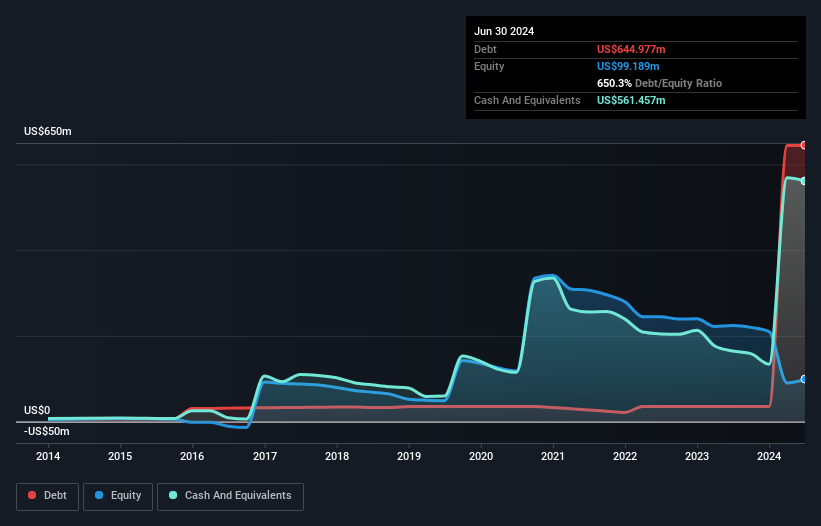- United States
- /
- Medical Equipment
- /
- NasdaqGS:IRTC
Is iRhythm Technologies (NASDAQ:IRTC) A Risky Investment?

David Iben put it well when he said, 'Volatility is not a risk we care about. What we care about is avoiding the permanent loss of capital.' It's only natural to consider a company's balance sheet when you examine how risky it is, since debt is often involved when a business collapses. We can see that iRhythm Technologies, Inc. (NASDAQ:IRTC) does use debt in its business. But the real question is whether this debt is making the company risky.
What Risk Does Debt Bring?
Debt is a tool to help businesses grow, but if a business is incapable of paying off its lenders, then it exists at their mercy. In the worst case scenario, a company can go bankrupt if it cannot pay its creditors. While that is not too common, we often do see indebted companies permanently diluting shareholders because lenders force them to raise capital at a distressed price. Of course, debt can be an important tool in businesses, particularly capital heavy businesses. The first thing to do when considering how much debt a business uses is to look at its cash and debt together.
Check out our latest analysis for iRhythm Technologies
How Much Debt Does iRhythm Technologies Carry?
The image below, which you can click on for greater detail, shows that at June 2024 iRhythm Technologies had debt of US$645.0m, up from US$34.9m in one year. On the flip side, it has US$561.5m in cash leading to net debt of about US$83.5m.

A Look At iRhythm Technologies' Liabilities
Zooming in on the latest balance sheet data, we can see that iRhythm Technologies had liabilities of US$97.9m due within 12 months and liabilities of US$722.1m due beyond that. On the other hand, it had cash of US$561.5m and US$85.5m worth of receivables due within a year. So it has liabilities totalling US$173.0m more than its cash and near-term receivables, combined.
Given iRhythm Technologies has a market capitalization of US$2.23b, it's hard to believe these liabilities pose much threat. However, we do think it is worth keeping an eye on its balance sheet strength, as it may change over time. The balance sheet is clearly the area to focus on when you are analysing debt. But ultimately the future profitability of the business will decide if iRhythm Technologies can strengthen its balance sheet over time. So if you want to see what the professionals think, you might find this free report on analyst profit forecasts to be interesting.
In the last year iRhythm Technologies wasn't profitable at an EBIT level, but managed to grow its revenue by 19%, to US$537m. That rate of growth is a bit slow for our taste, but it takes all types to make a world.
Caveat Emptor
Over the last twelve months iRhythm Technologies produced an earnings before interest and tax (EBIT) loss. To be specific the EBIT loss came in at US$101m. When we look at that and recall the liabilities on its balance sheet, relative to cash, it seems unwise to us for the company to have any debt. Quite frankly we think the balance sheet is far from match-fit, although it could be improved with time. Another cause for caution is that is bled US$96m in negative free cash flow over the last twelve months. So suffice it to say we do consider the stock to be risky. There's no doubt that we learn most about debt from the balance sheet. But ultimately, every company can contain risks that exist outside of the balance sheet. For example, we've discovered 2 warning signs for iRhythm Technologies that you should be aware of before investing here.
If you're interested in investing in businesses that can grow profits without the burden of debt, then check out this free list of growing businesses that have net cash on the balance sheet.
Valuation is complex, but we're here to simplify it.
Discover if iRhythm Technologies might be undervalued or overvalued with our detailed analysis, featuring fair value estimates, potential risks, dividends, insider trades, and its financial condition.
Access Free AnalysisHave feedback on this article? Concerned about the content? Get in touch with us directly. Alternatively, email editorial-team (at) simplywallst.com.
This article by Simply Wall St is general in nature. We provide commentary based on historical data and analyst forecasts only using an unbiased methodology and our articles are not intended to be financial advice. It does not constitute a recommendation to buy or sell any stock, and does not take account of your objectives, or your financial situation. We aim to bring you long-term focused analysis driven by fundamental data. Note that our analysis may not factor in the latest price-sensitive company announcements or qualitative material. Simply Wall St has no position in any stocks mentioned.
About NasdaqGS:IRTC
iRhythm Technologies
A digital healthcare company, engages in the design, development, and commercialization of device-based technology that provides ambulatory cardiac monitoring services to diagnose arrhythmias in the United States.
Reasonable growth potential with imperfect balance sheet.
Similar Companies
Market Insights
Community Narratives




